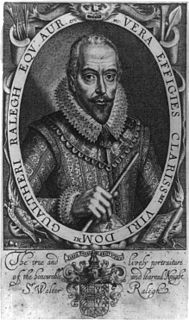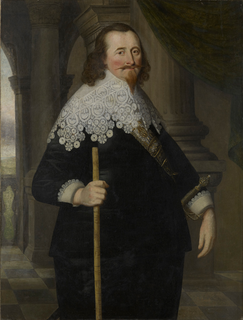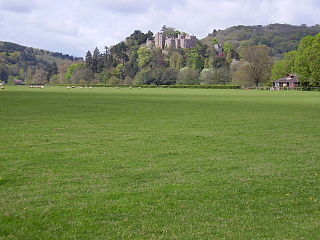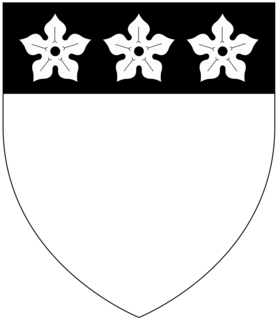
The Lord Warden of the Stannaries used to exercise judicial and military functions in Cornwall, England, in the United Kingdom, and is still the official who, upon the commission of the monarch or Duke of Cornwall for the time being, has the function of calling a stannary parliament of tinners. The last stannary parliament convened by a Lord Warden of the Stannaries sat in 1753.

Edward Courtenay, 1st Earl of Devon was an English nobleman during the rule of the Tudor dynasty. Born into a family with close royal connections, he was at various times considered a possible match for the two daughters of Henry VIII, both of whom became queens regnant of England. He was a second cousin to Edward VI, Mary I and Elizabeth I through King Edward IV.

Sir John Trelawny, 1st Baronet was a Cornish baronet and soldier from Trelawne, Cornwall. He was High Sheriff of Cornwall.

Lanteglos-by-Fowey is a coastal civil parish in south Cornwall, England, United Kingdom. It is on the east side of the tidal estuary of the River Fowey which separates it from the town and civil parish of Fowey. The South West Coast Path runs along the southern coasts of the parish and much of the southern part of the parish lies in the Polruan to Polperro Site of Special Scientific Interest managed by the National Trust.
John Mohun, 1st Baron Mohun of Okehampton was an English politician.

Sir William Mohun of Hall in the parish of Lanteglos-by-Fowey and of Boconnoc, both in Cornwall, was a Member of Parliament.

Sir Thomas Hele, 1st Baronet of Flete House in the parish of Holbeton in Devon, was three times elected a Member of Parliament for Plympton Erle, in 1626, 1628–29 and 1640 and once for Okehampton, in 1661–1670. He was a Royalist commander during the Civil War. He was created a baronet in 1627.

John Harris of Hayne in the parish of Stowford in Devon and of St. Michael's Mount in Cornwall, was a Member of Parliament.

Sir Reginald Mohun, 1st Baronet of Boconnoc in Cornwall, was a prominent member of the gentry of Cornwall and an MP.
Hugh Courtenay or Hugh de Courtenay is the name of:

Sir Hugh Courtenayof Boconnoc, Cornwall, was MP for Cornwall in 1446-47 and 1449-50. He was beheaded after the Battle of Tewkesbury in 1471.
Powderham is a former manor on the coast of south Devon, England, situated within the historic hundred of Exminster, about 6 miles (9.7 km) south of the city of Exeter and adjacent to the north-east of the village of Kenton. It consists in part of flat, formerly marshy ground on the west bank of the River Exe estuary where it is joined by its tributary the River Kenn, the site of Powderham Castle, originally the fortified manor house of Powderham. On the opposite side of the Exe is the small village of Lympstone and almost opposite is Nutwell Court in the parish of Woodbury, formerly the castle or fortified manor house of the powerful mediaeval Dynham family.

The feudal barony of Okehampton was a very large feudal barony, the largest mediaeval fiefdom in the county of Devon, England, whose caput was Okehampton Castle and manor. It was one of eight feudal baronies in Devonshire which existed during the mediaeval era.

Mohuns Ottery or Mohun's Ottery, is a house and historic manor in the parish of Luppitt, 1 mile south-east of the village of Luppitt and 4 miles north-east of Honiton in east Devon, England. From the 14th to the 16th centuries it was a seat of the Carew family. Several manorial court rolls survive at the Somerset Heritage Centre, Taunton, Somerset.

The feudal barony of Dunster was an English feudal barony with its caput at Dunster Castle in Somerset. During the reign of King Henry I (1100–1135) the barony comprised forty knight's fees and was later enlarged. In about 1150 the manors retained in demesne were Dunster, Minehead, Cutcombe, Kilton and Carhampton in Somerset, and Ham in Dorset.
Trethurffe is an historic estate in the parish of Ladock, near Truro, in Cornwall.

Ambrose Bellot, of Downton in Devon was a Member of Parliament for East Looe in Cornwall in 1597.
Hall in the parish of Lanteglos-by-Fowey in Cornwall, England, is an historic estate, most prominent as the seat of a branch of the Mohun family of Dunster Castle in Somerset. The family of Mohun of Hall was also seated at Bodinnick also in the parish of Lanteglos-by-Fowey and later at Boconnoc, both in Cornwall, and was one of the four co-heirs of Edward Courtenay, 1st Earl of Devon (1527–1556), feudal baron of Okehampton, etc., of Tiverton Castle, Okehampton Castle, etc., the last of the mediaeval Courtenay Earls of Devon. In recognition of this in 1628 the senior representative of the Mohun family of Hall was created Baron Mohun of Okehampton, namely John Mohun, 1st Baron Mohun of Okehampton (1595-1641) eldest son and heir of Sir Reginald Mohun, 1st Baronet (1564–1639) of Boconnoc. The family of Mohun of Hall died out in the male line in 1712, following the death in a celebrated duel of Charles Mohun, 4th Baron Mohun of Okehampton (1677-1712), who died without progeny. However, the family had long out-lived the senior Dunster line which died out in the male line in 1375, following the death of John de Mohun, 2nd Baron Mohun, KG, (c.1320-1375). Two monumental brasses survive in Lanteglos church to members of the Mohun family of Hall, namely Thomas Mohun and John Mohun (d.1508).

Hayne in the parish of Stowford in Devon, is an historic manor, situated about 11 miles south-west of Okehampton. The surviving Manor House, a grade II* listed building known as Hayne House was rebuilt in about 1810 by Isaac Donnithorne, who later adopted the surname Harris having married the heiress of Harris of Hayne.
Moulsford is an historic manor in the county of Berkshire in England. In the Middle Ages until 1497 the manor of Moulsford was a principal seat of the prominent Carew family, also seated at Carew Castle in Pembrokeshire and later at Mohuns Ottery in Devon.















